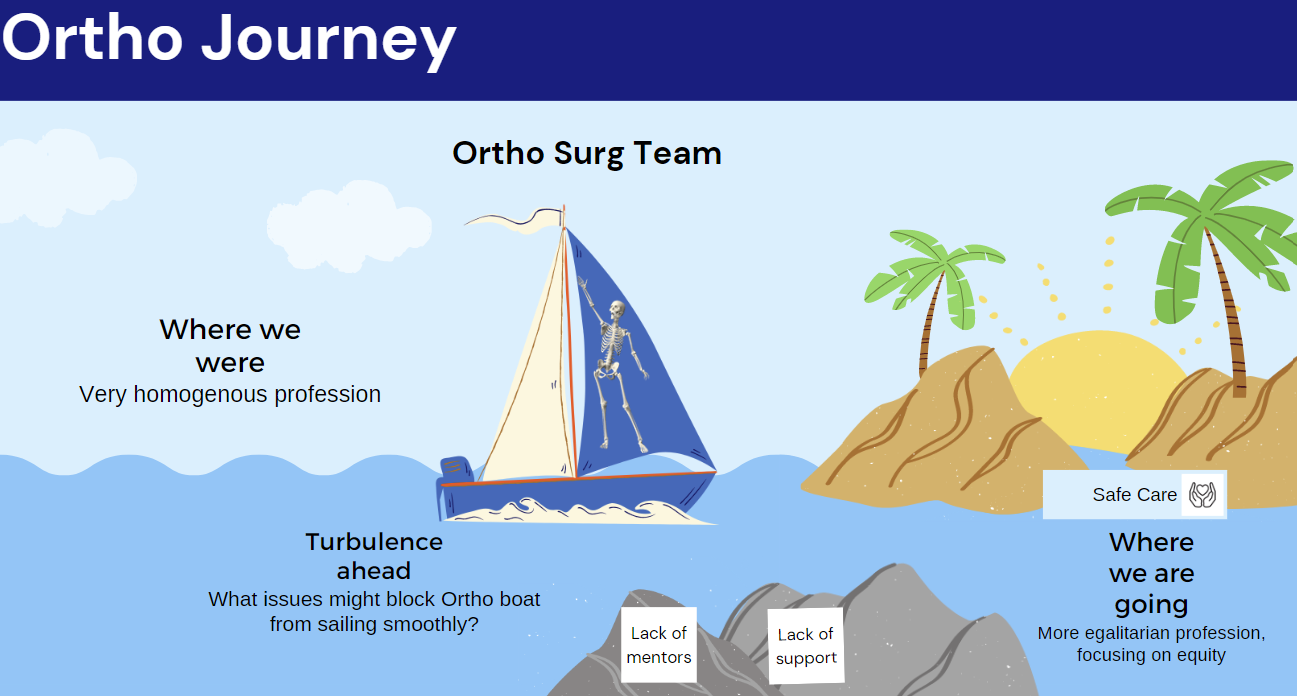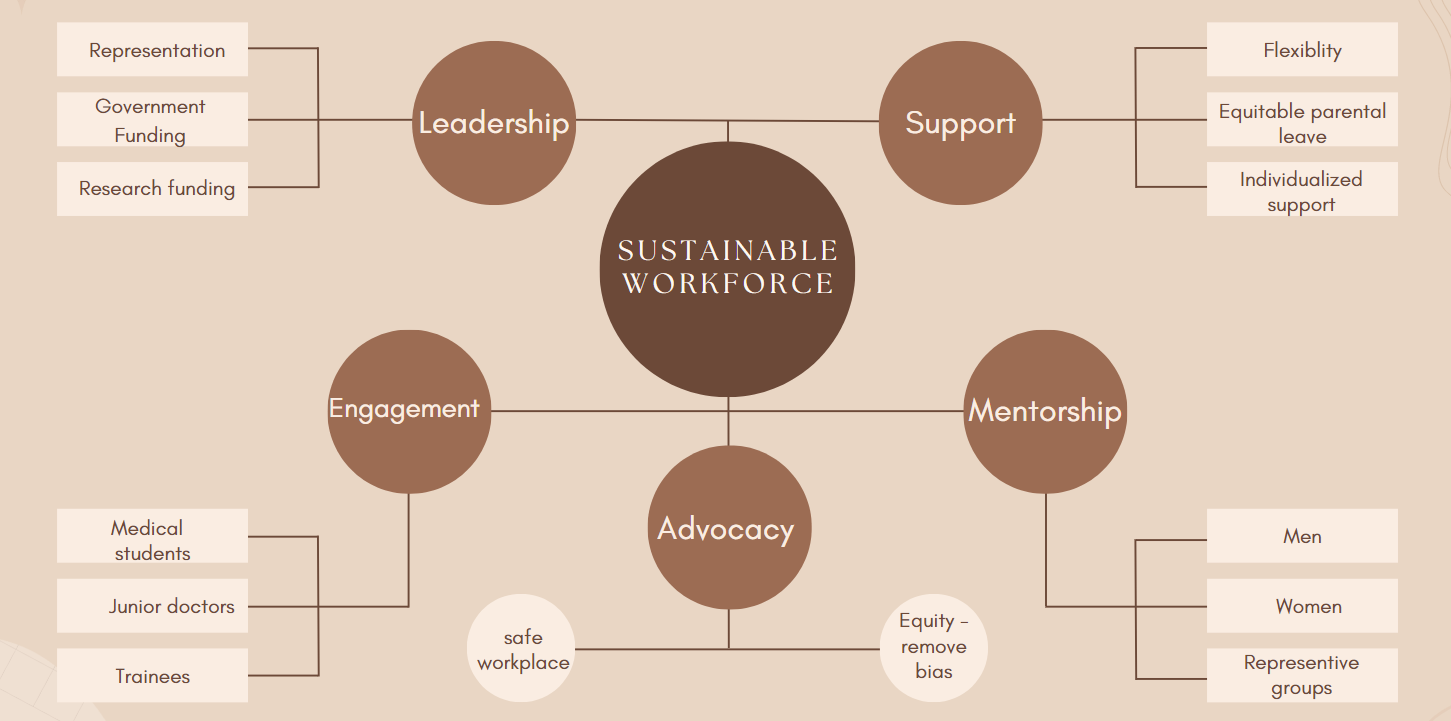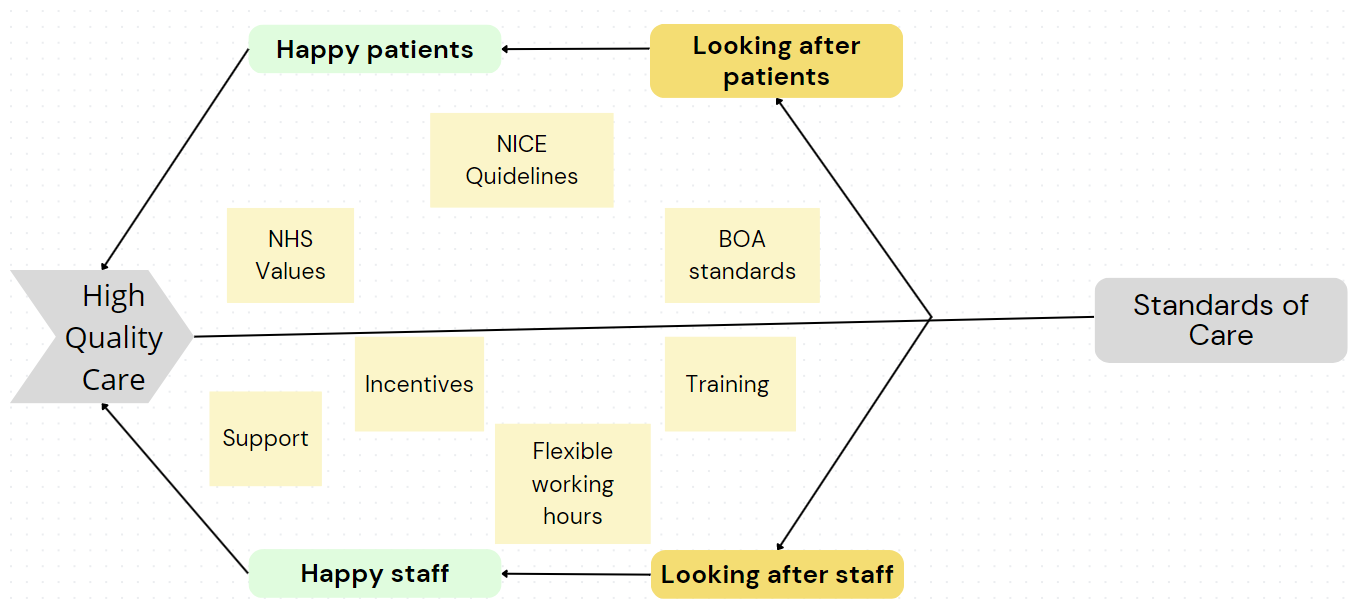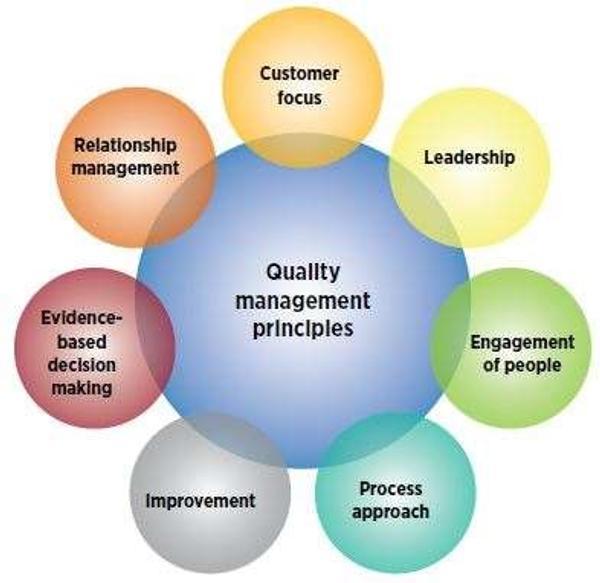The future of orthopaedics
By Aisha Jan
1st year medical student at the University of Edinburgh
|
This essay was a runner-up in the 2023 BOA Medical Student Essay Prize With the changing demographics and working practices within T&O, how can we sustain the workforce and standards of care currently provided within the NHS? |
The NHS is facing a major challenge in sustaining the workforce and standards of care within Trauma & Orthopedics (T&O)1. With an aging population and changing demographics, the demand for specialized medical services is increasing, and healthcare providers are facing new pressures2. To ensure that the quality of care remains efficient, a number of initiatives must be employed.
Before looking into initiatives, the journey of T&O must be discussed first. The past, present and future of the profession will be considered using an analogy of a sailing boat.

The Ortho Surg team boat represents the workforce, which historically was a homogeneous, male dominated sector3. Equal access to education led many women into the pursuit of studying medicine which then furthered their interest into T&O3. Globalisation contributed to a more diverse workforce as the number of International Medical Graduates (IMGs) and ethnic minority doctors increased4.
However, all is not smooth sailing. Lack of mentors and lack of support are some concerns that inhibit the profession from being fully egalitarian5. T&O’s vision of providing safe care may be compromised due to a lack of Equality, Diversity, and Inclusion (EDI) which is strongly associated with healthcare inequity6.
The focus on equity is essential to ensure a sustainable workforce (Figure 2). Active efforts must be employed, ensuring people from all backgrounds feel included. This can be achieved through advocacy to attain a psychologically safe workplace7. Other ways in which workforce sustainability is achieved, is through leadership, engagement, mentorship, and support.

Figure 2 – Producing a sustainable workforce
There is no disputing that Trauma and Orthopedics is vital to aiding the quality of life of humankind, therefore the government must ensure adequate funding is provided8. A portion of funding should contribute towards research into the ‘why and how’ of creating a more sustainable workforce.
Representation of people of all backgrounds must be included in leadership so that people can visualize a welcoming environment in T&O9. Engagement must start from ground level hence medical students, junior doctors and trainees must be exposed to and supported in T&O10. Mentorship is crucial in ensuring people envision a career in T&O regardless of background6. Women need to vision other women succeed therefore having female mentors is vital11. Men, can play an important role in providing mentorship opportunities as there are not as many women available12. Representative groups of all backgrounds (race, religion, culture, disability, and all other representations of people) should be involved in mentoring schemes. Organizations must work together to provide these mentorship opportunities.
Flexibility is key in providing support for trainees, some of whom are parents hence equitable parental leave is a must to ensure child and parental well-being13. Trainees must also be given individualized support as everyone has differing needs. For example, someone who is a carer has a unique set of needs which are different to a single person with no external responsibilities but is an IMG. Crèches, places to breast feed, return-to-work programs for those who have taken leave are all practical ways to support trainees but are not always available (e.g. NHS Lothian does not provide a crèche)14.
Lastly, a consideration of potential biases (conscious or unconscious) in the selection process should be studied and efforts pursued to eliminate these15. Representation on interview panels may prove to be beneficial in reducing selection bias15.
With changing working practices, T&O must ensure standards of care are maintained. The move to a competency-based curriculum allowed for flexibility, which contributes to workforce sustainability16. The curriculum update in 2021 used the generic professional capabilities and capabilities in practice to highlight that patient safety is at the heart of T&O training17.
To provide safe care of the highest quality, both patients and staff must be looked after (Figure 3).

Figure 3 – Maintaining high quality care
Conforming to BOA standards, NICE guidelines and NHS values result in standards of care being maintained and therefore ‘happy patients’. ‘Happy patients’ are not independent of ‘happy staff’18.
‘Happy staff’ are the result of not only also incentives (financial or otherwise), good work environment, training but also flexible working hours and support19.
Surgical training opportunities have been limited due to COVID-1920. Digital learning opportunities are currently used alongside surgery21. Innovations in T&O such as robotic surgery and deep learning have continued to advance the field through providing high quality, safe care22.
Recruitment and Retention of staff is a challenge. Many staff leave the NHS for private or work aboard due to more flexible hours (no nights) and higher pay15. Flexible (or reduced) working hours have been associated with decrease in burn out and better patient outcomes23.
Rules such as not being able to do bank work in the same NHS Trust as your workplace (in Scotland) have resulted in some non-surgical staff working through agencies in other trusts. This ultimately affects theatre lists and patient care provided therefore such managerial rules must be re-analysed critically.
To determine whether patients or staff are ‘happy’ and to maintain safe care, we can use quality assurance methods and obtain feedback (engagement) from these groups24. The ISO (International Organization for Standardization) 9000 series (Figure 4) can be applied to ensure standards of care are maintained. Patient focus is the core pillar upon which T&O functions25. Relationship management is determined by communication with patient and is key to their care25.

Leadership plays a critical role not only in sustainability of the workforce but also in providing safe care to patients27. Process approach includes looking at the process through which engagement is defined (i.e. determination of ‘happy patients or safe care’).
Modern medicine is a field that is founded upon evidence-based decision making hence any interventions must reflect this. Improvement stage ensures there is continuous improvement in patient care (this may be through innovations such as AI or robotics) however guidelines (BOA, NICE) must always be followed28.
Trauma and Orthopedics is an ever-evolving field with dynamic changes occurring rapidly. Whilst many transformations are occurring within the specialty, standards of care must be preserved, and the workforce sustained through methods discussed; quality management and taking care of patients and staff.
References
- J. Lin and J. Samora, "Quality Improvement Principles and Models," in Quality Improvement and Patient Safety in Orthopaedic Surgery, Cham, Springer, 2022, pp. 1-11.
- C. Folager, M. Bendsten, J. Brinchmann and M. Brittberg, "Aarhus Regenerative Orthopaedics Symposium (AROS) - Regeneration in the ageing population," Acta Orthopaedica, vol. 363, no. 2, pp. 1-7, 2017.
- E. Miller and D. LaPorte, "Barriers to Women Entering the Field of Orthopedic Surgery," Slack Jounals - Orthopedics, vol. 38, no. 9, pp. 530-533, 2015.
- M. Farag and I. Olaogun, "The Application of Digital Platforms in Supporting UK International Medical Graduates," Cureus, vol. 12, no. 10, pp. 1-6, 2020.
- R. Galloway, N. Chotai, L. Jeyaseelan, Chandrakumar and Charmilie, "The Experiences, Influences and Concerns of Future Orthopaedic Surgeons: Comparing Uk and non-UK Perspectives," British Jounal od Hospital Medicine, vol. 83, no. 12, pp. 1-15, 2022.
- M. Harrington, A. Rankin, A. Ladd and B. Mason, "The Orthopaedic Workforce Is Not as Diverse as the Population It Serves: Where Are the Minorities and the Women?," American Orthopedic Association , vol. 101, no. 6, pp. 1-6, 2019.
- P. Liamputtong, Social Inclusion, Research, and Practices, Hanoi: Springer, 2022.
- K. Hamid, P. Raut, B. Ahmed and W. Eardley, "Orthopedic Trauma and Recovery of Quality of Life: An Overview of the Literature," Clinical Medicine Insights: Trauma and Intensive Medicine, vol. 7, no. 2, pp. 1-8, 2016.
- E. Taylor, R. Darcus, J. Oni and L. Suleiman, "An Introduction to the Orthopaedic Diversity Leadership Consortium," The Journal of Bone and Joint Surgery, vol. 105, no. 4, pp. 267-275, 2022.
- K. Gerull, P. Rarameswaran, D. Jeffe and A. Salles, "Does Medical Students' Sense of Belonging Affect Their Interest in Orthopaedic Surgery Careers? A Qualitative Investigation," Clinical Orthopaedics and Related Research, vol. 479, no. 10, pp. 2239-2252, 2021.
- M. Summers, W. Ramalingam, R. Matar and D. Jaime, "Closing the Gender Gap: Barriers to Success for Recruitment and Retention of the Female Orthopaedic Surgery Applicants," JBJS Reviews, vol. 8, no. 9, pp. 2-11, 2020.
- T. Newman, M. Parry, R. Zakeri and V. Pegna, "Gender diversity in UK surgical specialties: a national observational study," BMJ, vol. 12, no. 2, pp. 1-8, 2022.
- J. Compton, C. Hajewski and A. Pygley, "Pregnancy and Parental Leave During Orthopaedic Surgery Residency," Iowa Orthopedic Journal, vol. 41, no. 1, pp. 19-23, 2021.
- NHS Lothian , "FREEDOM OF INFORMATION – STAFF CHILDCARE ASSISTANCE," NHS Board, 12 07 2019. [Online]. Available: https://org.nhslothian.scot/FOI/RequestAndResponseRegister/FOIs/3651.pdf. [Accessed 28 02 2023].
- F. Patterson, Designing and Evaluating Selection and Recruitment in Healthcare, Cham: Palgrave Macmillan, 2018.
- R. Harries, V. Gokani, P. Smitham and E. Fitzgerald, "Less than full-time training in surgery: a cross-sectional study evaluating the accessibility and experiences of flexible training in the surgical trainee workforce," BMJ, vol. 6, no. 4, pp. 1-7, 2015.
- British Orthopaedic Association, "T&O Curriculum," BOA, 01 08 2021. [Online]. Available: https://www.boa.ac.uk/learning-and-events/new-curriculum/new-curriculum-for-trainees.html. [Accessed 28 02 2023].
- R. Moss, "Happy staff = happy patients: OT's Robina Moss speaks to multiple and independent companies to uncover how they strive to provide a better working environment for their practice staff," Optometry Today, London, 2016.
- S. Qaisar and G. Abid, "Psychological contract breach and happiness at work in healthcare sector: Double mediation of colleague support and deviant workplace behaviour," Pakistan Journal of Commerce and Social Sciences, vol. 16, no. 1, pp. 50-69, 2022.
- British Orthopaedic Association, "Trainee associations provide an urgent call to action to protect the future surgical workforce," 06 07 2022. [Online]. Available: https://www.boa.ac.uk/resources/trainee-associations-provide-an-urgent-call-to-action-to-protect-the-future-surgical-workforce.html. [Accessed 27 02 2023].
- J. Stambough, B. Curtin, J. Gililland and G. Guild, "The Past, Present, and Future of Orthopedic Education: Lessons Learned From the COVID-19 Pandemic," The Journal of Arthroplasty, vol. 35, no. 7, pp. 60-64, 2020.
- C. Li, L. Wang, C. Perka and A. Trampuz, "Clinical application of robotic orthopedic," BMC musculoskeletal disorders, vol. 22, no. 1, pp. 1-14, 2021.
- L. Jacquet, "Do breaks from surgery improve the performance of orthopaedic," Journal of Health Economics, vol. 85, no. 2, pp. 1-15, 2022.
- M. Harteloh, "Understanding the quality concept in health care," Accreditation and Quality Assurance, vol. 9, no. 3, pp. 92-95, 2004.
- D. Chang and W. Chen, "Impact of the bidirectional relationship between communication and cognitive efficacy on orthopedic patient adherence behavior," BMC Health , vol. 199, no. 22, pp. 1-10, 2022.
- American Society for Quality, "WHAT IS THE ISO 9000 STANDARDS SERIES?," ASQ, 25 08 2015. [Online]. Available: https://asq.org/quality-resources/iso-9000. [Accessed 28 02 2023].
- A. Anoushiravani, Z. Sayeed, M. El-Othmani and P. Wong, "High Reliability of Care in Orthopedic Surgery," Orthopedic Clinics, vol. 47, no. 4, pp. 689-695, 2016.
- K. Karthik and S. Joydeep, "Robotics in trauma and orthopaedics," The Annals of The Royal College of Surgeons of England, vol. 100, no. 6, pp. 8-18, 2018.
